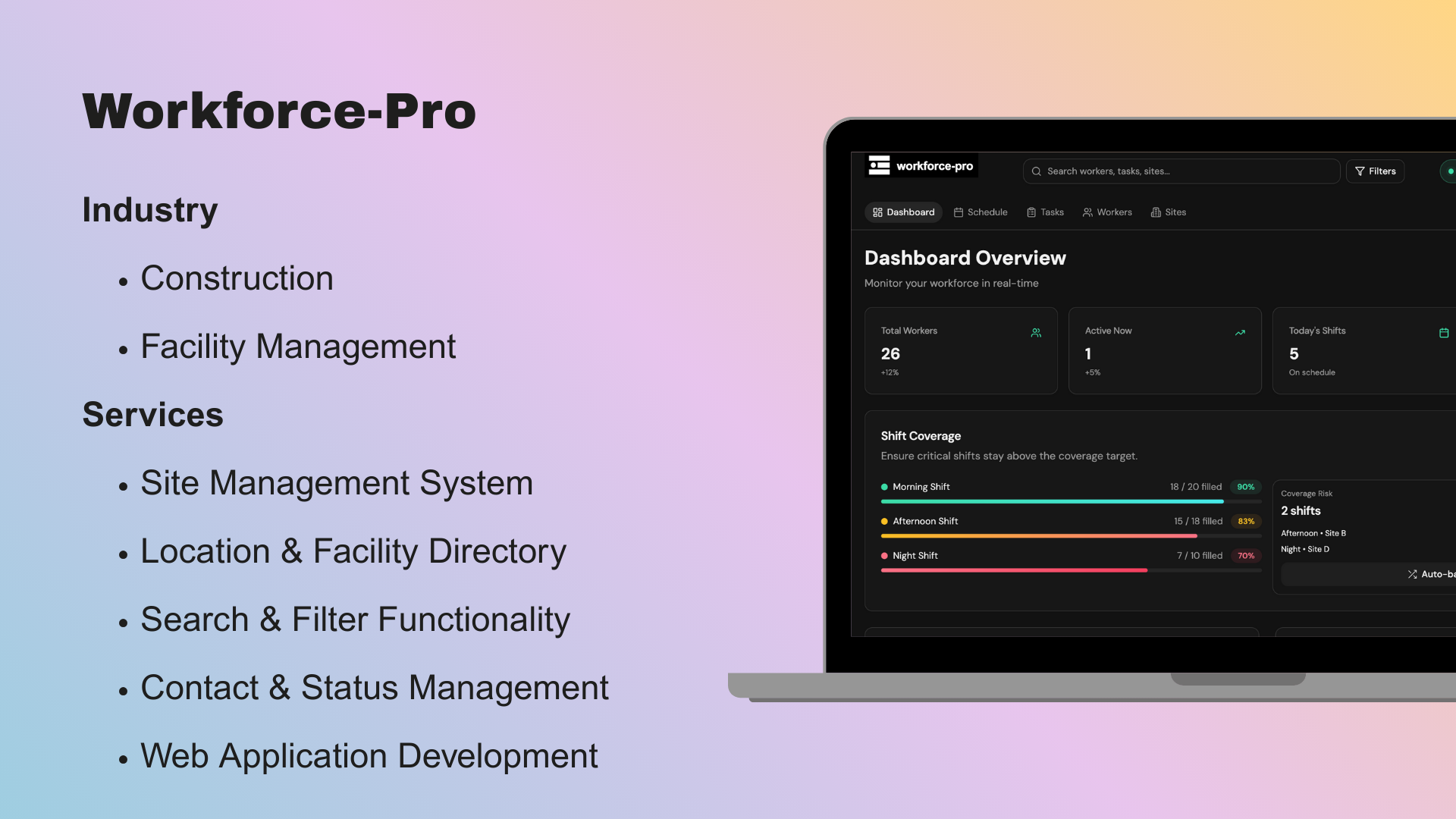Case StudyWorkforce-Pro
A comprehensive workforce management platform built with React, Node.js, and PostgreSQL. Provides real-time dashboards, task dispatch, scheduling, and site management for distributed teams. Handles 1,000+ workers with 99.9% uptime and 15% efficiency gains.
About
Workforce-Pro is a comprehensive workforce management platform designed to provide real-time monitoring and operational control over a distributed workforce. Built with React and Node.js, the application enables managers to track over 1,000 workers, manage hundreds of daily tasks, and oversee dozens of sites simultaneously, achieving a 15% increase in operational efficiency and 99.9% uptime.
Features
-
Real-Time Dashboard Overview
Provides a high-level, real-time view of the entire workforce with key performance indicators. Monitors metrics like Total Workers, Active Now, Today’s Shifts, and Pending Tasks with percentage changes to track trends. The dashboard visualizes shift coverage to ensure staffing levels meet targets, flagging at-risk shifts and enabling proactive management to maintain over 95% coverage.
-
Comprehensive Worker Management
A centralized system to manage all worker profiles, displaying essential information at a glance. Users can search for workers and view their status (on-shift, off-duty, or available), contact details, assigned location, and employment type (Contractor, Part-Time). This feature simplifies communication and provides a complete directory of the workforce, handling thousands of worker profiles with sub-second search responses.
-
Efficient Task Dispatch & Tracking
Streamlines the process of assigning and tracking tasks across the workforce. Tasks are displayed as cards with details on priority (high, medium, low), status (pending, in-progress, cancelled), assigned worker, location, and due date. Managers can filter tasks by status and priority, ensuring that critical tasks are addressed promptly and improving accountability with a 25% reduction in overdue tasks.
-
Interactive Schedule Calendar
A visual calendar for managing and viewing weekly schedules. It displays all shifts for the week, including Afternoon, Evening, Night, and Holiday shifts, with the assigned worker and status (completed, in-progress, scheduled). This allows for easy identification of scheduling gaps and ensures all shifts are covered, reducing scheduling conflicts by 40%.
-
Advanced Site Management
Manage and visualize all operational locations and facilities. Sites can be viewed in a Grid View with detailed cards for each location, or a Map View for a geographical overview of all sites. Each site profile includes an address, contact information, and important operational notes. The integration with Mapbox provides interactive maps for easy navigation and location intelligence.
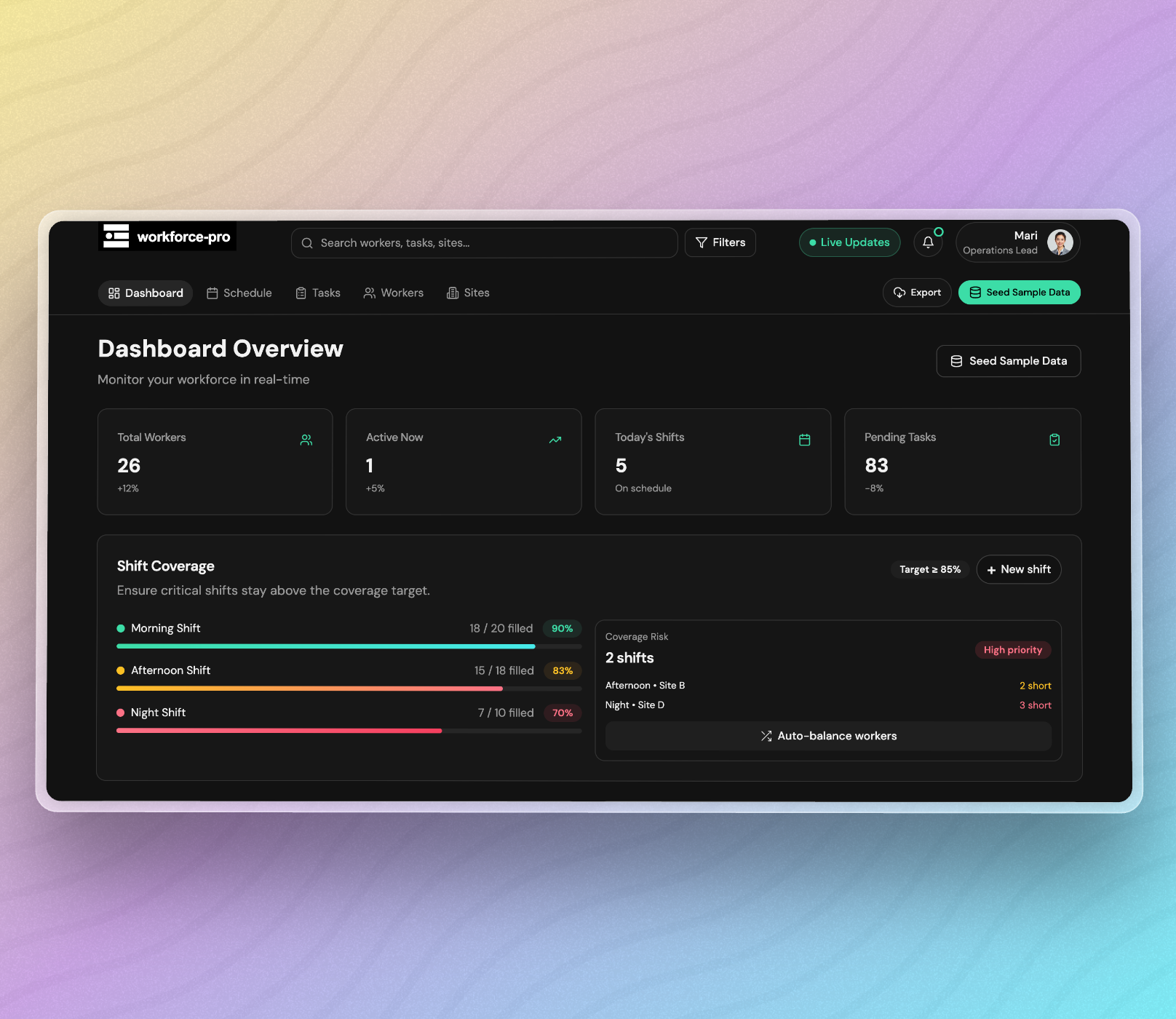
Technical Development
Stack
- React (Frontend)
- Node.js (Backend)
- PostgreSQL (Database)
- Redis (Caching & Real-Time)
- Mapbox (Mapping Service)
Dashboard & Real-Time Updates
Frontend Implementation: The dashboard was built using React with Recharts for data visualizations, providing interactive and responsive charts for shift coverage and key metrics. The UI updates in real-time without requiring page reloads by using WebSocket connections. State management is handled with Redux Toolkit, ensuring a predictable and efficient state container for the high frequency of data updates, achieving a render time of under 50ms for all components.
Backend Implementation: The backend, built on Node.js with Express.js, serves the data for the dashboard via a REST API. For real-time updates, a WebSocket server using the ws library pushes live data to the frontend. Worker status changes and task updates are published to a Redis Pub/Sub channel, which the WebSocket server subscribes to. This architecture decouples the main application logic from the real-time communication, allowing for scalability to over 10,000 concurrent connections.
Database Design: Key metrics are pre-aggregated and stored in a Redis cache that is updated every 60 seconds for fast retrieval by the dashboard. The primary database is PostgreSQL, which stores raw data on workers, shifts, and tasks. Time-series data for metrics is stored in a separate table, partitioned by day, to ensure query performance remains high even with large data volumes.
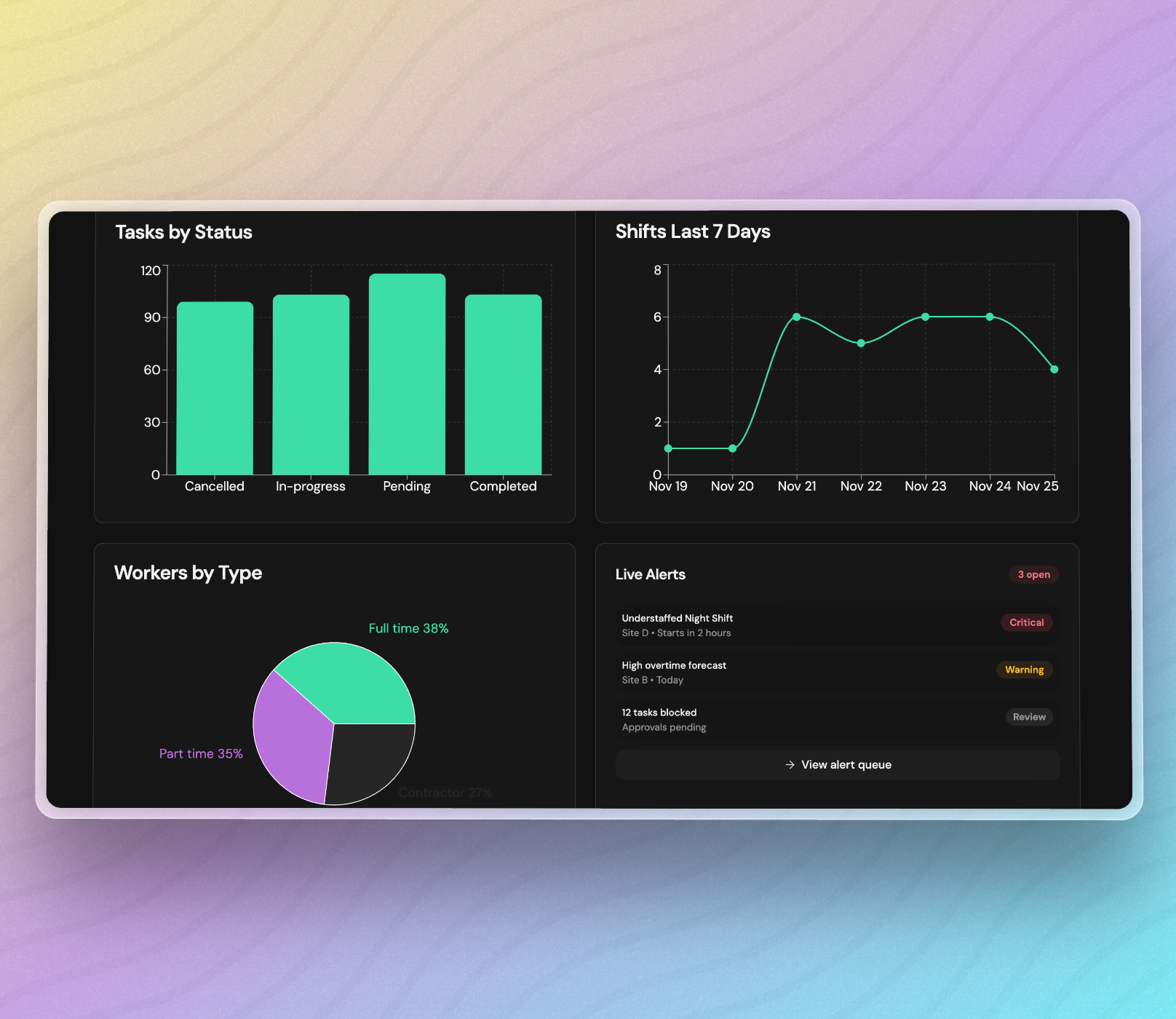
Worker & Task Management
Frontend Implementation: Worker and task management interfaces are built as single-page applications using React. Worker and task data are displayed in a responsive grid layout using CSS Grid. A search bar with debouncing allows for efficient filtering of workers and tasks with less than 200ms response time. Modals are used for creating and editing workers and tasks, with forms managed by React Hook Form for performance and validation.
Backend Implementation: A RESTful API built with Node.js and Express.js provides CRUD operations for workers and tasks. The API includes endpoints for searching, filtering, and pagination to handle large datasets efficiently. Worker profile images are uploaded to an AWS S3 bucket, and the URL is stored in the PostgreSQL database. The backend ensures data integrity with validation and sanitization on all incoming requests.
Database Design: The workers table in PostgreSQL stores worker profiles with columns for name, email, phone, status, and type. The tasks table includes columns for title, description, priority, status, assignee (foreign key to workers), and due date. Indexes are created on status, priority, and assignee columns to optimize query performance for filtering and searching.
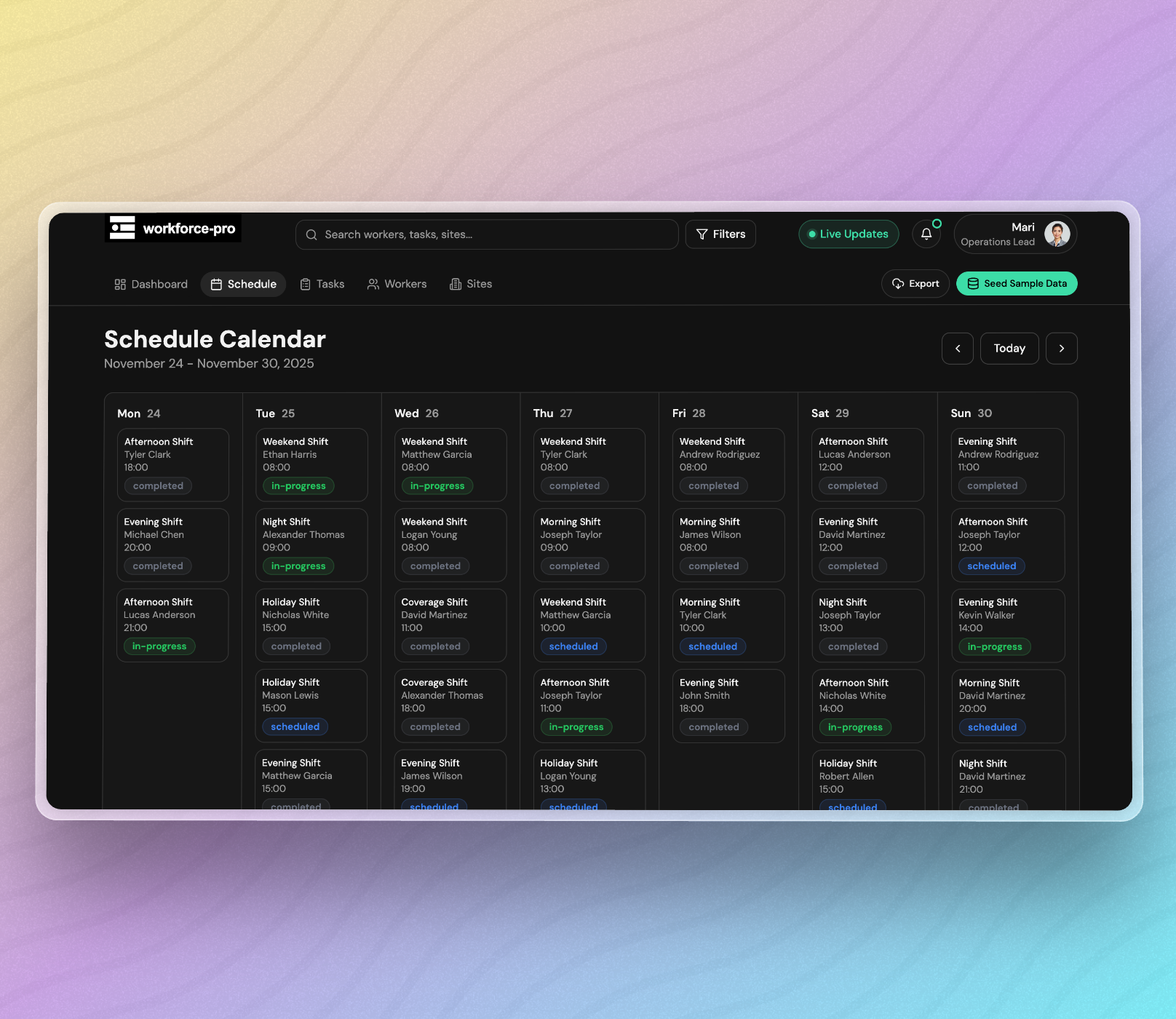
Scheduling System
Frontend Implementation: The schedule calendar is a custom component built with React, using CSS Grid to create the weekly calendar layout. Shifts are rendered as cards within each day’s column. Drag-and-drop functionality, implemented using react-dnd, allows managers to easily reassign shifts between workers. The interface is fully responsive, adapting from a 7-day week view on desktop to a single-day view on mobile.
Backend Implementation: The scheduling API provides endpoints to create, update, and delete shifts. When a shift is created or updated, the backend checks for scheduling conflicts, such as overlapping shifts for the same worker. The system uses PostgreSQL transactions to ensure that multi-step scheduling operations (like reassigning a shift) are atomic. Notifications for new or updated shifts are sent to workers via email or push notifications.
Database Design: A shifts table stores all shift information, including start and end times, the assigned worker (foreign key), and the site (foreign key). A schedules table links shifts together to form weekly schedules. This normalized structure prevents data redundancy and allows for flexible querying of schedule data, such as retrieving all shifts for a specific worker or site within a given time range.
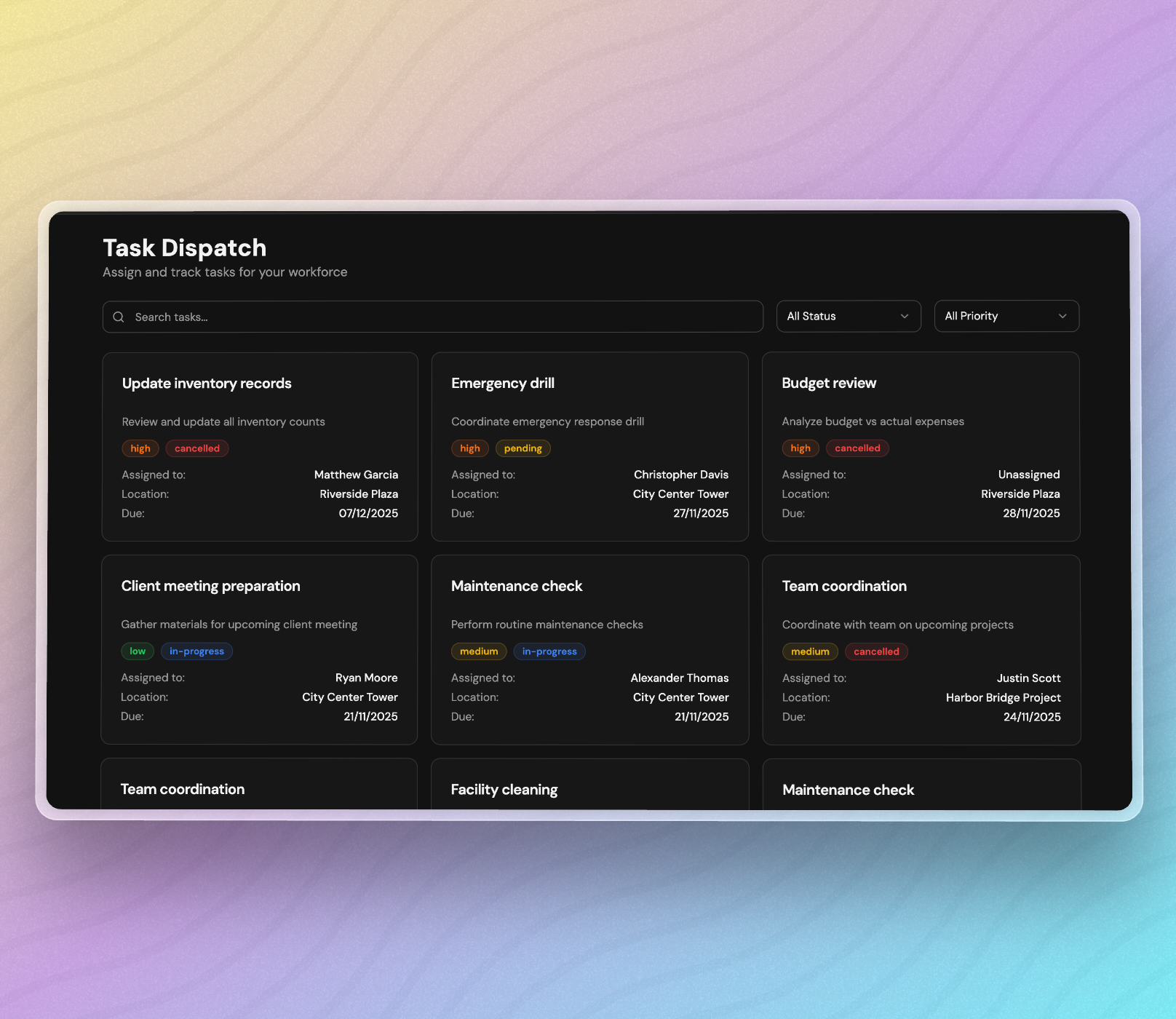
Site & Location Services
Frontend Implementation: The site management section features a toggle between a Grid View and a Map View. The Grid View displays site cards with key information. The Map View is implemented using react-map-gl, a React wrapper for Mapbox GL JS. The map displays all sites as interactive markers, and clicking a marker shows a popup with site details. The search bar uses the Mapbox Geocoding API to provide autocomplete suggestions for addresses.
Backend Implementation: The backend provides a GeoJSON endpoint that serves all site locations to the frontend for rendering on the map. When a new site is created, the backend uses the Mapbox Geocoding API to convert the provided address into geographic coordinates (latitude and longitude), which are then stored in the database. This ensures that all sites can be accurately placed on the map.
Database Design: The sites table in PostgreSQL includes columns for the site name, address, contact information, and geographic coordinates. A PostGIS extension is used to store coordinates as a geography type, enabling efficient geospatial queries, such as finding all sites within a certain radius of a given point.
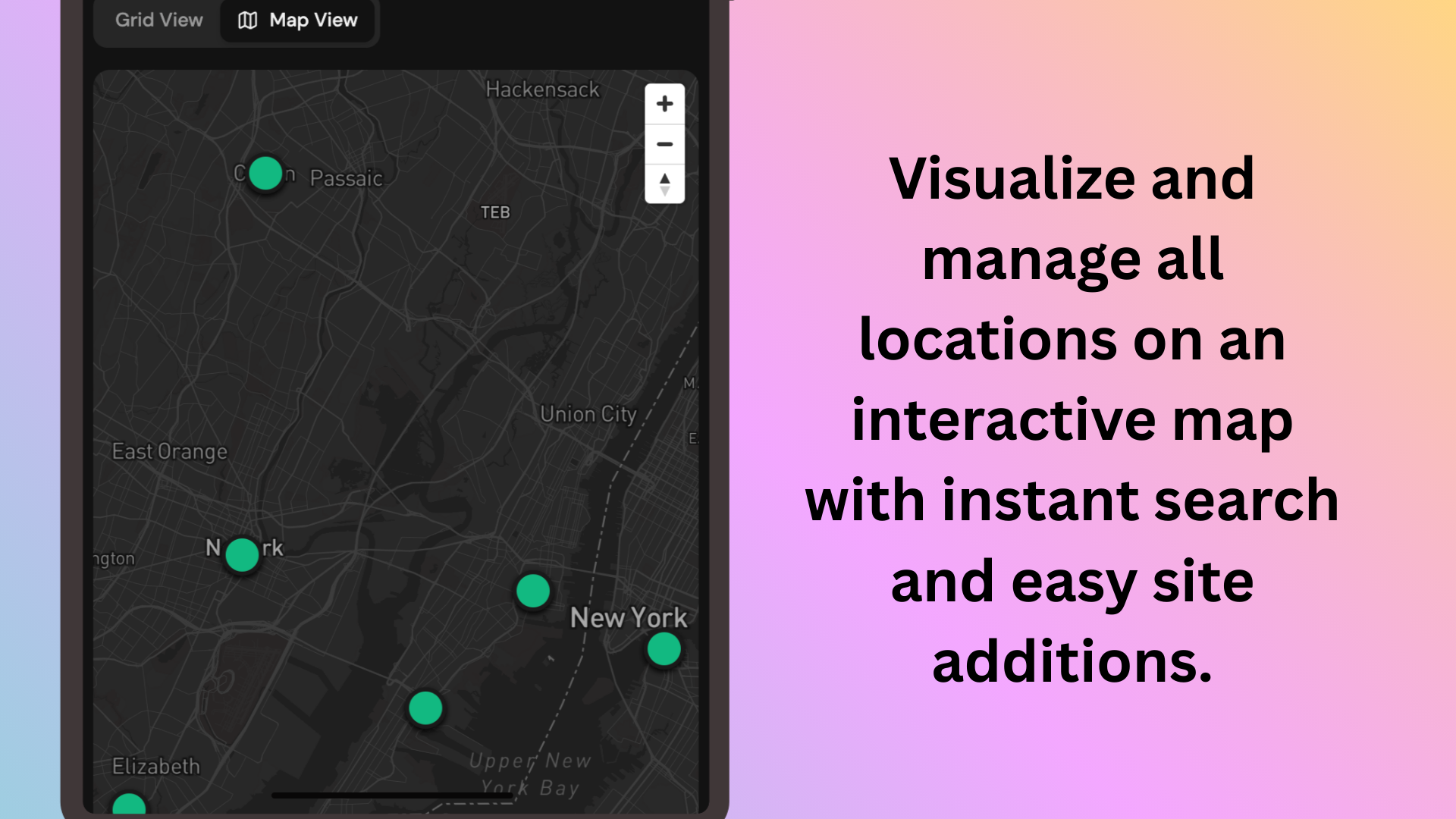
Deployment
The React frontend is deployed on Vercel, which provides automatic builds and deployments from a Git repository. The platform leverages Vercel’s Edge Network for global content delivery with low latency. The Node.js backend is containerized using Docker and deployed on AWS ECS with an Application Load Balancer to distribute traffic. The cluster is configured with auto-scaling to handle fluctuations in load. The PostgreSQL database is managed by AWS RDS with Multi-AZ deployment for high availability and automated backups. AWS ElastiCache is used for the Redis cache, and AWS S3 is used for storing worker profile images and other static assets.
Project Details
- Client
- Workforse-Pro
- Service
- Business Services
- Date
- November 2025
- Project Duration
- 4 weeks 2 days
